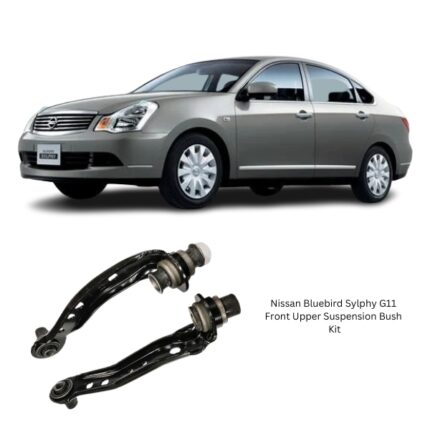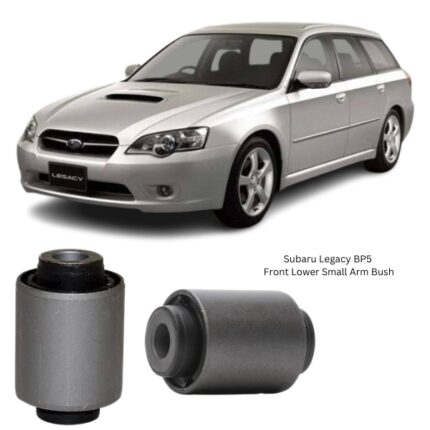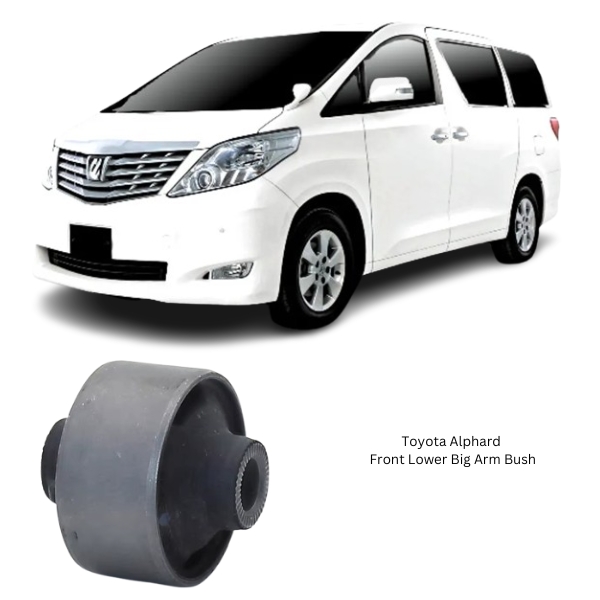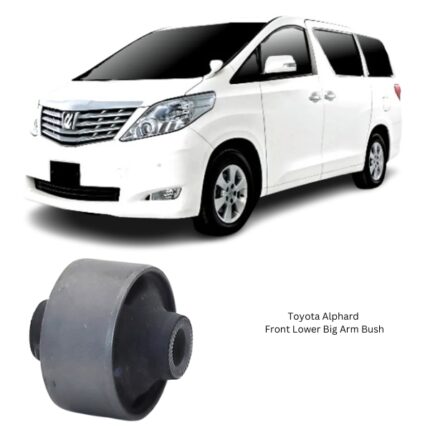Get Toyota Alphard Front Lower Big Arm Bush 48655-42050 in Kenya
The Front Lower Big Arm Bush is a critical component in a vehicle’s suspension system, precisely engineered to absorb road shocks, reduce vibrations, and maintain optimal alignment of the front suspension geometry. Although small in appearance, its function is integral to the overall driving dynamics, ride quality, and long-term health of other suspension parts.
Mounted within the lower control arm assembly—often referred to as the “big arm” due to its structural size and load-bearing function—the bush acts as a pivot point that allows the suspension arm to move up and down as the wheels react to varying road surfaces. The Front Lower Big Arm Bush plays a dual role: it supports the control arm during compression and rebound movement, while also insulating the chassis from the harshness of road impact and noise.
Function and Purpose
The Front Lower Big Arm Bush serves as the flexible link between the lower control arm and the subframe or chassis of the vehicle. Its main functions include:
-
Vibration Damping
Absorbs road shocks and vibrations, ensuring they don’t transfer into the vehicle cabin, contributing to a smooth and comfortable ride. -
Control Arm Articulation
Provides the necessary flexibility for the control arm to pivot vertically during suspension movement, without allowing excessive lateral or fore-aft movement. -
Alignment Retention
Helps maintain correct suspension geometry (toe, caster, and camber angles), ensuring stable and predictable handling. -
Noise Isolation
Prevents direct metal-to-metal contact within the suspension assembly, reducing creaking, knocking, or clunking noises during driving. -
Load Distribution
Spreads the stress and impact forces evenly across the control arm and chassis mounting points, reducing wear on adjacent components. -
Dynamic Stability
Maintains consistent contact between the tires and road surface by supporting proper wheel movement under cornering, braking, and acceleration.
Without a functioning lower arm bush, the control arm would not be able to perform its job effectively, leading to handling instability, misalignment, and compromised safety.
Construction and Materials
The Front Lower Big Arm Bush is designed to endure intense stress, weather extremes, and frequent articulation throughout the lifespan of the vehicle. Its design reflects a careful balance between strength, elasticity, and durability.
Main Components:
-
Outer Sleeve
A cylindrical steel or aluminum shell that is pressed into the housing of the lower control arm. This forms the rigid boundary for the bushing. -
Inner Sleeve
A central metal tube through which a suspension mounting bolt passes. It provides a fixed point for the arm to pivot around. -
Elastomeric Core
The rubber or polyurethane insert situated between the outer and inner sleeves. This core compresses and flexes to absorb motion, vibration, and shock. -
Bonding Material
The elastomer is chemically or mechanically bonded to both the inner and outer sleeves to prevent slippage and ensure proper force transfer. -
Void Geometry (optional)
Some bushings are designed with engineered voids, channels, or cuts to fine-tune directional stiffness and compliance, allowing optimal control during different types of motion.
Materials vary depending on application, but commonly used are:
-
Natural Rubber – for comfort, flexibility, and good vibration absorption.
-
Polyurethane (PU) – for enhanced durability, stiffness, and performance in high-load or sporty applications.
Performance Characteristics
A high-quality Front Lower Big Arm Bush provides several performance advantages critical to vehicle control and suspension efficiency:
-
Fatigue Resistance
Capable of enduring repeated cycles of compression and shear without cracking, deforming, or separating. -
Load Bearing Strength
Built to withstand vertical and lateral loads imposed by braking, turning, and road irregularities. -
Temperature Tolerance
Maintains performance across a wide range of temperatures, from freezing cold to intense engine bay heat. -
Chemical Resistance
Resists degradation from exposure to oil, grease, brake fluid, and road salt. -
Longevity
Properly maintained, it can last for tens of thousands of kilometers without significant performance loss.
Symptoms of Wear and Failure
Like all rubber or polymer components in the suspension system, the Front Lower Big Arm Bush is subject to wear over time due to environmental exposure, load stress, and mechanical fatigue.
Common Signs of Wear:
-
Clunking or Knocking Noises
Noises coming from the front suspension area, especially when going over bumps or during braking, may indicate looseness caused by worn bushings. -
Excessive Vibration
A failed bush may no longer absorb road vibration effectively, leading to more pronounced feedback through the steering wheel or cabin. -
Misalignment or Steering Pull
Worn bushings can cause the control arm to shift, affecting wheel alignment and resulting in uneven steering or vehicle pull to one side. -
Uneven Tire Wear
Misalignment caused by loose control arms leads to uneven tread wear, typically visible on the inner or outer edges of the front tires. -
Poor Braking Response
A shifting suspension geometry during deceleration can lead to instability or delayed braking reaction. -
Visual Damage
Cracks, splits, or complete detachment of the rubber from its sleeve are tell-tale signs during a visual inspection.
Ignoring these symptoms can lead to accelerated wear of other suspension components such as tie rods, ball joints, or even steering rack assemblies.
Installation and Replacement
Replacing a Front Lower Big Arm Bush often requires specialized tools due to the press-fit nature of the component. The procedure typically includes:
-
Vehicle Lifting
Safely raise and support the vehicle, and remove the wheel to gain access to the suspension assembly. -
Control Arm Removal
Disconnect the control arm from the chassis and knuckle. It may require detaching the sway bar or shock absorber. -
Old Bushing Removal
Use a hydraulic press or bushing extraction tool to remove the worn bush without damaging the control arm. -
New Bushing Installation
Press the new bushing into place, ensuring correct alignment and seating. -
Reassembly and Torqueing
Reinstall the control arm and all hardware. Torque bolts to manufacturer specifications and verify proper orientation. -
Wheel Alignment
A professional wheel alignment is essential after bushing replacement to correct any suspension geometry changes.
Maintenance and Inspection
The Front Lower Big Arm Bush should be visually inspected during routine suspension checks, especially:
-
After heavy off-road use or rough terrain driving
-
When replacing shocks, springs, or control arms
-
During vehicle alignment service
-
Following a collision or pothole impact
While there is no set mileage for replacement, most bushings should be inspected between 60,000 to 100,000 kilometers, depending on use.
Benefits of Timely Replacement
-
Improved Handling – Steering response and road feel are sharper and more predictable.
-
Enhanced Comfort – Reduces road harshness and vibrations entering the cabin.
-
Extended Tire Life – Maintains correct alignment and prevents premature tire wear.
-
Component Longevity – Reduces strain on other suspension parts like shocks, ball joints, and sway bars.
-
Increased Safety – Keeps the front wheels aligned during braking, cornering, and acceleration.
Follow us on Facebook for more parts.





Reviews
Clear filtersThere are no reviews yet.